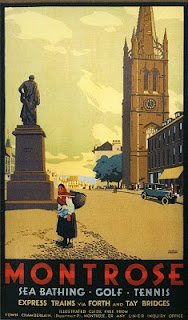No. 3 in an occasional series about the seemingly endless list of Austin Cooper namesakes in my family tree. This Austin Cooper is a remote cousin of my great grandmother’s to whom I hadn’t paid much attention. That changed a couple of weeks ago when I bought a beautiful coffee table book of old railway posters of Scotland
Austin Cooper, graphic artist (1890-1964)
I’m old enough to remember the beautiful watercolour prints of scenes from around the country which used to grace the old wooden carriage compartments, and the combination of that artwork with the scenery of Scotland AND the romance of steam rail travel was irresistible. I was happily leafing through when the name Austin Cooper leapt off the page.
LNER travel poster from the 1920s, by Austin Cooper
He was born in
In 1922 he settled in
Summer and winter campaigns for London Transport, 1924
From 1936 to 1940 he also served as the first principal of Reimann School of Industrial Art, a private school of German origin for practical design and the first commercial art school in
Poster for a V&A exhibition of posters, 1931
Cooper’s book “Making a Poster” was published by The Studio in 1939. It ran to several impressions and is something of a classic design text. In it he expressed his design philosophy: “The functions of a poster are dual: to arrest the attention and then, having caught the eye of the passer-by, to deliver a message swiftly, convincingly, effectively.”
In 1943 he abandoned poster design to concentrate on painting. But public acclaim for his advertising designs and paintings led to a post-war show at the London Gallery in 1948, the first of many. Almost half a century after his death, his railway posters regularly command hundreds of pounds when they come up for sale at auction houses. (More elsewhere in Tall Tales on Austin's market town posters for LNER and his Tube posters for museums!)
Montrose (1925) by Austin Cooper











Gorgeous posters. Fascinating to think you're related to this artist. Lucky you.
ReplyDeleteHullo--stumbled onto your blog while reading about Coopers. Austin was my great-great uncle. It's true that his father, Frederick Douglass Cooper, had a farm at the time of Austin's birth, but he was never much of a farmer (according to Austin's brother, F.D. was born at Killenure Castle, Co. Wexford--not an ideal start for wheat-farming in Manitoba). F.D. drifted to South Africa, where he married Florence Fairbridge, and his first child, Honor/Honoria was born there. From SA he emigrated to Canada, where Austin, Sisson, and Dorothea (from whom I'm descended) were born, before he abandoned the farm for a Canadian insurance company. Then he returned to Ireland (as did his brother, "Uncle Willie," apparently the Archdeacon of Calgary!). Then he moved the family to Wales (insurance again). Sisson became a newspaperman in South Africa & FD eventually ended up in British Columbia. Austin's late work became purely abstract; a couple of his pieces were acquired by the Tate.
ReplyDeleteMy sister is a design historian in London and has requested me to find an obituary on Austin Cooper. if you have one, I would be grateful if you could send it to me please. Naomi @naomiwakan.com
Deletethank you
Naomi Beth Wakan
Hi there Captain! I'm so pleased that you left a comment, and very grateful for the detail about this family. Yes, I've visited Killenure Castle, a fine castle but one imagines not the home of a hands-on farmer! I'm interested that FD drifted to South Africa - as you may have seen, my recent post about John Cooper-Chadwick also connects the familt to the area, and I'm still reading JCC's fascinating 1894 memoirs. Slightly before FD's time I suppose. I've always been an admirer of this Austin's poster work, although I only recently discovered the family connection, and I've never seen his later abstract work. (I do now have a copy of his "Making a Poster.") I'm particularly pleased to have found that he designed the Montrose poster above, as I went to school there! You can contact me privately via my profile here if you'd like to keep in touch about family matters - I'd be delighted!
ReplyDelete